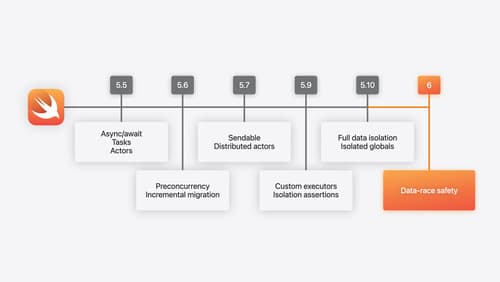What are the new Swift concurrency primitives
Asked on 2025-06-12
1 search
The new Swift concurrency primitives introduced in Swift 6 include low-level synchronization tools such as atomics and mutexes. These are part of the synchronization module and are designed to provide efficient, lock-free implementations on the platform. Atomic values should be stored in let properties for safe concurrent access, and all operations on atomics are explicit with memory ordering arguments. Similarly, a mutex should be stored in a let property and can be accessed concurrently through the withLock method, which ensures mutually exclusive access. These primitives are part of the improvements aimed at achieving data race safety in Swift 6.
For more details, you can refer to the session What’s new in Swift (28:43).

What’s new in Swift
Join us for an update on Swift. We’ll briefly go through a history of Swift over the past decade, and show you how the community has grown through workgroups, expanded the package ecosystem, and increased platform support. We’ll introduce you to a new language mode that achieves data-race safety by default, and a language subset that lets you run Swift on highly constrained systems. We’ll also explore some language updates including noncopyable types, typed throws, and improved C++ interoperability.

What’s new in Swift
Join us for an update on Swift. We’ll talk about workflow improvements that make you more productive, and new and modernized library APIs for fundamental programming tasks. We’ll show examples of Swift adoption throughout more layers of the software stack. Finally, we’ll explore new language features for both improving approachability of concurrency, and achieving peak performance when you need it.

Embracing Swift concurrency
Join us to learn the core Swift concurrency concepts. Concurrency helps you improve app responsiveness and performance, and Swift is designed to make asynchronous and concurrent code easier to write correctly. We’ll cover the steps you need to take an app through from single-threaded to concurrent. We’ll also help you determine how and when to make the best use of Swift concurrency features – whether it’s making your code more asynchronous, moving it to the background, or sharing data across concurrent tasks.
